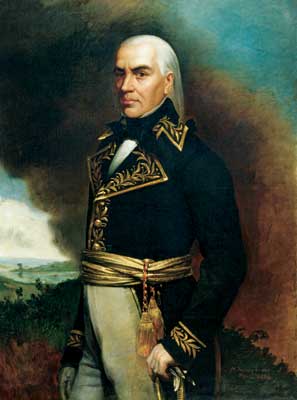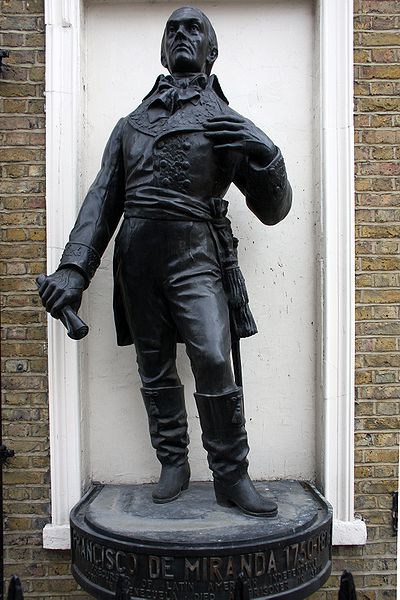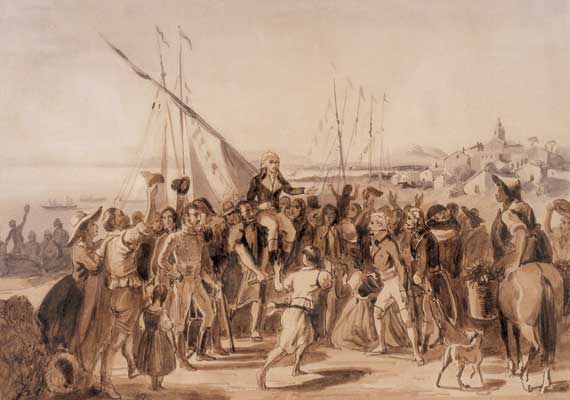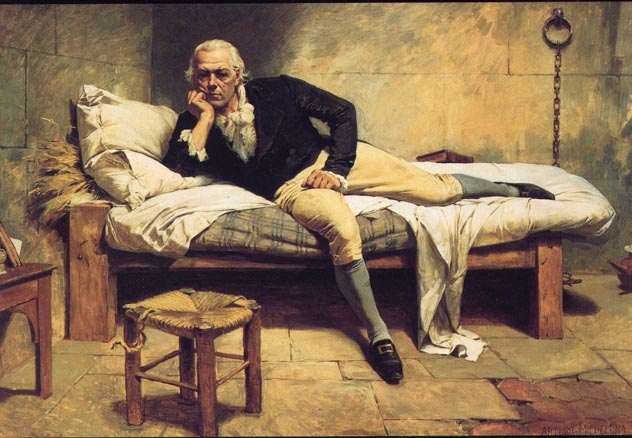<Back to Index>
- Geographer and Ethnologist Henry Rowe Schoolcraft, 1793
- Painter Fra Bartolomeo di Pagholo (Baccio della Porta), 1472
- Venezuelan Revolutionary Sebastián Francisco de Miranda y Rodríguez, 1750
PAGE SPONSOR


Sebastián Francisco de Miranda y Rodríguez (Caracas, March 28, 1750 – in prison, El Arsenal de la Carraca, Cadiz, July 14, 1816), commonly known as Francisco de Miranda, was a Venezuelan revolutionary. Although his own plans for the independence of the Spanish American colonies failed, he is regarded as a forerunner of Simón Bolívar, who during the Spanish American wars of independence successfully liberated a vast portion of South America. Miranda led a romantic and adventurous life. An idealist, he developed a visionary plan to liberate and unify all of Spanish America by his own military initiatives on behalf of an independent Spanish America in 1812. He was handed over to his enemies and four years later, in 1816, died in a Spanish prison. Within fourteen years of his death, however, most of Spanish America was independent.
Sebastian Francisco de Miranda was born on March 28, 1750, in Caracas, Venezuela. His father, Sebastian de Miranda Ravelo, was a wealthy merchant from the Canary Islands, and his mother, Francisca Antonia Rodríguez de Espinoza, was a wealthy Venezuelan. Growing up, Miranda enjoyed a wealthy upbringing, attending the finest private schools, while being slightly discriminated against for his Canarian roots. Miranda was not necessarily a member of high society growing up, as his heritage was continually put into question by the Criollo aristocracy. As a consequence of that, Miranda grew up conceited and arrogant and used the false title of "Count of Miranda" in Russia and Sweden.
Miranda, who had bought himself a commission as a General of the Spanish Army around 1771 (something not unusual in the European armies at the time), became interested in the American Revolutionary War, while serving as Captain of the Aragon Regiment and aide-de-camp to General Juan Manuel de Cajigal y Monserrat, (1739 – 1811). Under Cajigal, Miranda participated in the 1781 Battle of Pensacola, which saw British West Florida fall into Spanish hands, and was promoted to lieutenant colonel. He participated in the Capture of The Bahamas and carried news of the island's fall to his superior Bernado de Galvez. Galvez was angry that the Bahamas expedition had gone ahead without his permission and he imprisoned Cajigal and had Miranda arrested. Miranda was later released, but this experience of Spanish officialdom may have been a factor in his subsequent conversion to the idea of independence for Spain's American colonies.
He later returned to the United States in
1783, where he met, among others, George
Washington, Thomas
Paine, Alexander
Hamilton, Henry
Knox, and Thomas
Jefferson, embarking from Boston for England on December 15, 1784. Much
later, after his adventures in England, (until August 9, 1785), Miranda
went to Venice, Padua, Verona, Mantua, Parma, Modena, Bologna, Florence, Pisa, Lucca, Livorno, Rome and Naples,
(from November 12, 1785 to around March 16, 1786 where he moved on
April 2, 1786 to the modern-day Dubrovnik,
then named Ragusa and
a vassal city of the Ottoman Empire), Istanbul in Turkey (until
September 23, 1786), Russia, (from September 26, 1786 until September
7, 1787, slightly under one year), Sweden, (in Stockholm as from
September 10, 1787 until November 2, 1787), Norway, (from November 10,
1787 until departing from Karlskrona in Sweden from December 17, 1787),
Denmark (from September 23, 1787 until March 10, 1788 after being
received in Denmark orders of capture from Spain no later than January
22, 1788), the Free Hanseatic Town of Hamburg, (from (April 1, 1788
until the April 27, 1788), the Free Town of Bremen, (leaving on April
27), Holland, (from around the May 2, 1788 until around June 16, 1788),
some actual Belgian towns and German cities along the Rhine river,
Swiss Basel, (arrival July 30, 1788, and then again after touring
German-speaking Switzerland on October 12, 1788), Swiss Geneva (arrival
September 25, 1788), and France, (entry around the 3rd and 4th weeks of
September 1788, two stays in Marseilles, the second departing there
towards Bordeaux on February 26, 1789 via inland waterways), travels to
Rouen, Le Havre and Paris around May 5, 1789, getting papers as "Mr.
Meeroff from Livonia" to arrive in Dover, (England) and then London on
June 19, 1789, (taking lodgings at the house of his British friend, "A
Barlow", at 47 Jermyn Street). The
attempts to abduct Miranda by the diplomatic representatives of Spain
failed as the Russian Ambassador in London, Semyon Vorontsov,
declared on August 4, 1789 to the Secretary of
State for Foreign Affairs, Francis
Osborne, 5th Duke of Leeds, that
Sebastian
de Miranda, although a Spanish subject, was a member of the
Russian diplomatic mission in London at the service of H.R.H. Empress Catherine II of
Russia. His letter to Catherine II is a good example of the
lecherous manners
of some of the eighteenth-century courtesans. In Russia, he used the
surname Meeroff and he left several children who latter emigrated to
the US and Argentina and are currently well known academicians. Miranda
made use of the Spanish-British diplomatic row known as the Nootka Crisis in
February 1790 to present to some British Cabinet ministers his ideas
about the independence of Spanish territories in South America. Later on, after fighting for
Revolutionary France, Miranda made his home in London, where he had two children, Leandro
(1803 – Paris, 1886) and Francisco (1806 – Cerinza, Colombia, 1831), with his housekeeper, Sarah Andrews, whom
he later married. During this earlier times in London he had met Colonel William
S. Smith, secretary to John
Adams's American Legation. From
1791, Miranda took an active part in the French
Revolution. In Paris,
he befriended the Girondists Jacques Pierre
Brissot and Jérôme
Pétion de Villeneuve, and he briefly served as a general
in the section of the French
Revolutionary Army commanded
by Charles
François Dumouriez, fighting in the 1792 campaign in the Low Countries.
Miranda was first arrested in April 1793 on the orders of Antoine Quentin
Fouquier-Tinville, Chief Prosecutor of the Revolution, and
accused of conspiring against the republic with Charles
François Dumouriez, the renegade general. Though indicted
before the Revolutionary Tribunal – and under attack in Jean-Paul Marat's L'Ami du peuple –
he conducted his defence with such calm eloquence that he was declared
innocent. Even so, the campaign of Marat and the rest of the Jacobins against him did not weaken.
He was arrested again in July 1793, when he was incarcerated in La Force prison,
effectively one of the ante-chambers of death during the prevailing Reign of Terror.
Appearing again before the tribunal, and mustering all his soldierly
courage, he accused the Committee of
Public Safety of
tyranny, in disregarding his previous acquittal. Miranda
seems to have survived by a combination of good luck and political
expediency: the revolutionary government simply could not agree what to
do with him. He remained in La Force even after the fall of Robespierre in
July 1794, and was not finally released until the January of the
following year. Now convinced that the whole direction taken by the
Revolution had been wrong, he started to conspire with the moderate
royalists against the Directory,
and
was even named as the possible leader of a military coup. He was
arrested and ordered out of the country, only to escape and go into
hiding. He
reappeared after being given permission to remain in France, though
that did not stop his involvement in yet another monarchist plot in
September 1797. The police were ordered to arrest the "Peruvian
general", as the said general submerged himself yet again in the
underground. With no more illusions about France, or
the Revolution, he
left for England in a Danish boat, arriving in Dover in January 1798.
His name remains engraved on the Arc
de Triomphe, which was built
during the First
Empire.
His
life has long been associated with the struggle of the Spanish colonies
in Latin America for independence. Miranda envisioned an independent empire consisting of all the
territories that had been under Spanish and Portuguese rule, stretching from the Mississippi
River to Cape Horn.
This empire was to be under the leadership of a hereditary emperor
called the "Inca", in honor of the great Inca Empire,
and would have a bicameral
legislature. He conceived the name Colombia for this empire, after the
explorer Christopher
Columbus. With
informal British help, Miranda led an attempted invasion of the Captaincy
General of Venezuela in
1806. At the time Britain was at war with Spain, an ally of Napoleon.
In November 1805 Miranda travelled to New York, where he rekindled his
acquaintance with Colonel William S. Smith,
who
introduced him to merchant Samuel G. Ogden (who would later be
tried, but acquitted, for helping organize Miranda's expedition). Miranda then went to Washington
for private meetings with President Thomas Jefferson and his Secretary of State James Madison,
who met with Miranda but did not involve themselves or their nation in
his plans, which would have been a violation of the Proclamation of
Neutrality of
1793. Miranda privately began organizing a filibustering
expedition to
liberate Venezuela. Among the volunteers who served under him in this
revolt was David G. Burnet of the United States, who
would later serve as interim president of the Republic of
Texas after its
secession from Mexico in 1836. Miranda hired a
ship from Ogden, which he rebaptized the Leander in honor of his oldest son. In Jacmel, Haiti, Miranda acquired two other ships, the Bee and the Bacchus, and their crews. It is here in Jacmel
on March 12, when Miranda made, and raised on the Leander, the first Venezuelan flag,
which he had personally designed. On April 28 the small fleet was
overtaken by Spanish war ships off the coast of Venezuela. Only the Leander escaped. Sixty men were captured and put
on trial, and ten were sentenced to death. The Leander and the expeditionary force regrouped on
the British islands of Barbados and Trinidad. The expedition landed at La
Vela de Coro on
August 3, captured the fort and raised the flag for the first time on
Venezuelan soil. Before dawn the next morning the expeditionaries
occupied Coro,
but found no support from the city residents. Rather than risk a
defeat, the small royal force in the city fell back from the city
escorting refugees and to await reinforcements. Realizing that he could
not hold the city for long, Miranda ordered his force to set sail again
on August 13, and he spent the next year in the British
Caribbean waiting
for reinforcements that never came. On his return to Britain, he was
met with better support for his plans from the British government. In
1808 a large military force to attack Venezuela was assembled and
placed under the command of Arthur
Wellesley,
but Napoleon's invasion of Spain suddenly transformed Spain into an
ally of Britain, and the force instead went there to fight in the Peninsular
War. Venezuela
achieved de facto independence on April 19,
1810, when a junta was established and the
colonial administrators deposed. The Junta sent a delegation to Great Britain to get British recognition
and aid. This delegation, which included future Venezuelan notables Simón
Bolívar and Andrés
Bello,
met with and persuaded Miranda to return to his native land. There he
agitated for the provisional government to declare independence.
Miranda gathered around him a group of similarly-minded individuals and
helped establish an association, la
Sociedad Patriotica, modeled on the political clubs of
the French Revolution. By the end of the year the Venezuelan provinces
elected a congress to deal with the future of the country, and Miranda
was chosen as the delegate from El Pao,
Barcelona Province. On July 5, 1811, it formally declared Venezuelan
independence and established a republic. The congress also adopted his tricolor as the Republic's flag. The
following
year Miranda and the young Republic's fortunes turned.
Republican forces failed to subdue areas of Venezuela which had remained royalist.
In addition, Venezuela's loss of the Spanish market for its main export, cocoa, meant
that
an economic crisis set in, which mostly hurt the middle and lower
classes, who lost enthusiasm for the Republic. Finally a powerful
earthquake and
its aftershocks hit
the country, which caused large numbers of deaths and serious damage to
buildings, mostly in republican areas. It did not help that it hit on
March 26, 1812, as services for Maundy Thursday were
beginning. The Caracas Junta had been established on a Maundy Thursday
as well, so the earthquake fell on its second anniversary in the
liturgical calendar. This was interpreted by many as a sign from Providence,
and
many, including those in the Republican army, began to secretly
plot against the Republic or outright defect. Other provinces refused
to send reinforcements to Caracas Province. Worse still, whole
provinces began to switch sides. On July 4, an uprising brought
Barcelona over to the royalist side. Neighboring Cumaná, now cut
off from the Republican center, refused to recognize Miranda's
dictatorial powers and his appointment of a commandant general. By the
middle of the month many of the outlying areas of Cumaná
Province had also defected to the royalists. With these circumstances a
Spanish marine frigate captain, Domingo
Monteverde,
operating out of Coro, was able to turn a small force under his command
into a large army, as people joined him on his advance towards Valencia,
leaving Miranda in charge of only a small area of central Venezuela. In these dire circmstances the
government appointed Miranda generalissimo,
with broad political
powers. By mid-July Monteverde had taken Valencia, and Miranda
thought the situation was hopeless.
He started negotiations with Monteverde and finalized an armistice on
25 July 1812. He then went to the port of La Guaira intending to leave
on a British ship before the royalists arrived, although under the
armistice there was an amnesty for political offenses. Then-Colonel
Bolívar and other revolutionary officers claimed that they
regarded this action as treasonous.
In
one of Bolívar's most morally dubious acts, Bolívar
and the others arrested and handed Miranda over to the Spanish Royal
Army. Bolívar claimed afterwards that he wanted to shoot him as
a traitor but was restrained by the others; Bolívar's reasoning
was that "if Miranda believed the Spaniards would observe the treaty,
he should have remained to keep them to their word; if he did not, he
was a traitor to have sacrificed his army to it". Ironically,
it was by handing over Miranda to the Spanish that Bolívar
assured himself a passport from the Spanish authorities (passports
which, nevertheless, had been guaranteed to all republicans who
requested them by the terms of the armistice), which allowed him to
leave Venezuela unmolested. Miranda
never saw freedom again. His case was still being processed, when he
died in a prison cell at the Cuatro Torres Fort at the Arsenal of La
Carraca, outside of Cádiz in 1816. He was buried in a mass grave,
making it impossible to identify his remains, so an empty tomb has been
left for him in the National
Pantheon of Venezuela. The oil painting by the Venezuelan artist Arturo
Michelena titled, Miranda en la
Carraca (1896),
which portrays the hero in the Spanish jail where he died, has become a
graphic symbol of Venezuelan history, and has immortalized the image of
Miranda for generations of Venezuelans.

